Fishing for bream in winter on the current
Many winter bream anglers prefer to fish exclusively in stagnant waters. Meanwhile, during the freeze-up period, fishing for bream in the current with the right choice of place, using the most suitable tackle, bait and bait for the given conditions, can not only be as good as fishing in calm water, but also surpass it at times. However, fishing in such conditions has a number of differences from fishing in still water. Without studying them, fishing will not be effective and not interesting. Therefore, let's try in this article to figure out how to catch bream in the winter on the current.
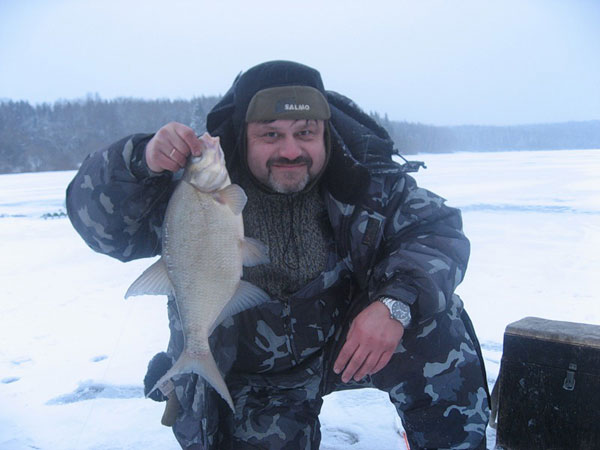
The specifics of catching bream during the winter
Unlike fishing in stagnant water bodies, fishing for bream in winter on the current has a number of features. They must be taken into account both when completing tackle and in the process of fishing:
- Fishing for bream under conditions of constant inflow of fresh oxygen continues throughout the winter fishing season, in contrast to lakes and low-flow reservoirs, where in the middle of winter there is a noticeable decrease in fish activity.
- The equipment of winter fishing rods on the current for bream, in comparison with stagnant reservoirs, should be more durable and reliable, and the equipment used should be heavier.
- The baits used must contain a large amount of heavy components or ballast.
- Feeding is carried out by means of a separate bait hole located upstream of the fishing site.
Where and when to catch bream during the winter
Catching bream in winter from ice on the current is successful throughout the winter. The places where fish accumulate differ depending on the freeze-up period:
- At the beginning and end of winter, bream concentrates at a relatively shallow depth of 2–3 meters near the coast.
- In the middle of winter, bream prefers to stay at large (from 4-5 meters) depths with a small current.
In winter, bream, as a typical bottom dweller, does not change its favorite places. On the river, the following areas will be the most promising for winter bream fishing:
- reaches with a weak current, hard clayey, clayey-sandy, silty-clayey bottom;
- channel ditch;
- upper and lower edges of the pits;
- deep places under steep slopes;
- deep extended pits with a flat and hard bottom - "bream tables".
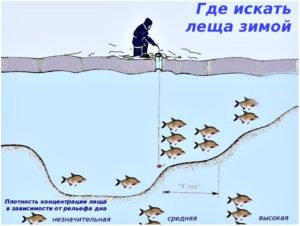
The success of catching bream on the river is facilitated by the correct timing of the fishing season. The correct choice of the time interval during the day allows you to fish in the most productive and exciting way:
- Small and medium-sized bream is caught on the river from 7-8 am to 3-4 pm.
- When catching large specimens, the most productive night catching of bream is in winter - at night on the current this fish takes well from midnight to 3-4 in the morning
Affects the activity of bream and the weather: the fish is very sensitive to pressure drops, temperature, precipitation, wind. From the observations of fishermen in catching bream, the following regularities of the influence of weather conditions on fish activity operate:
- Bream is most active in the daytime on days 2-3 of the thaw, characterized by cloudy weather without precipitation and strong winds.
- The biting weakens or stops altogether with a sharp drop in pressure, as well as on days with strong gusts of wind, heavy snowfalls.
- At night, bream bites under constant pressure and cloudy weather without precipitation.
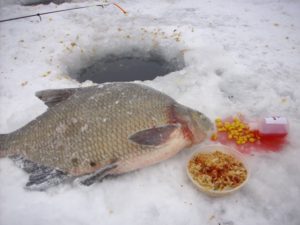
What to catch bream on during the winter
In ice fishing, such tackles are used for catching bream in the winter on the current, as:
- winter float rod;
- jigsaw tackle;
- winter feeder.
Winter float rod
Float tackle for bream in winter is used in low current.
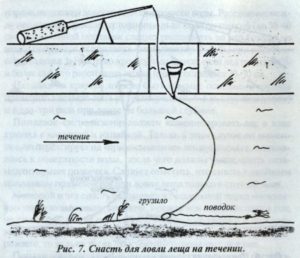
It consists of the following components:
- a fishing rod of the "Balayka" type with a special support - legs - worn on a whip;
- colorless winter fishing line with a section of 0.12-0.14 mm;
- a small winter float fixed movably on the main line;
- sinkers or heavy large jig weighing 10-15 grams, located at the end of the main line;
- a leash made of monofilament fishing line with a section of 0.1-0.12 mm and a length of 30-50 cm, located 30-40 cm above the sinker. Small jigs such as "Drobinka", "Ovsinka" and hooks No. 14-16 with a long forearm are tied to the leash;
- in order to improve the sensitivity of the tackle, in addition to the float, a flexible metal nod 10-15 cm long is installed on it.
They fish with this tackle all day long. The main nozzle is 2-3 bloodworms, 3-4 burdock moth larvae, maggot.
Winter jigsaw tackle
A winter jigging rod for catching bream in the current is used, like a float rod, at a low or medium water flow rate.
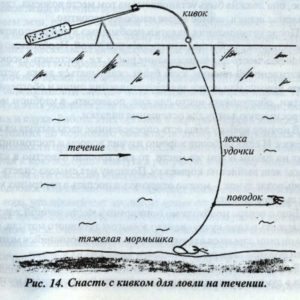
The jigsaw tackle consists of the following parts:
- a fishing rod of the "Balayka" type;
- main line with a section of 0.12-0.14 mm;
- rigid nod from a metal plate 8-12 cm long;
- two jigs - the lower heavy one and the upper lighter one, fixed 10-15 cm above the heavy one both directly on the fishing line and on a short leash 5-10 cm long;
- the upper jig is very often replaced with a small hook No. 14-16, tied to a leash 5-10 cm long.
The technique of following such a tackle in the current is its slow rise from the bottom with low-amplitude oscillations and pauses of 3-4 seconds every 30-40 cm.
Video: winter fishing for a borer on the course
Winter feeder
The most catchy tackle, which is becoming more and more widespread among anglers, used in ice fishing for bream in the current, is the winter feeder.
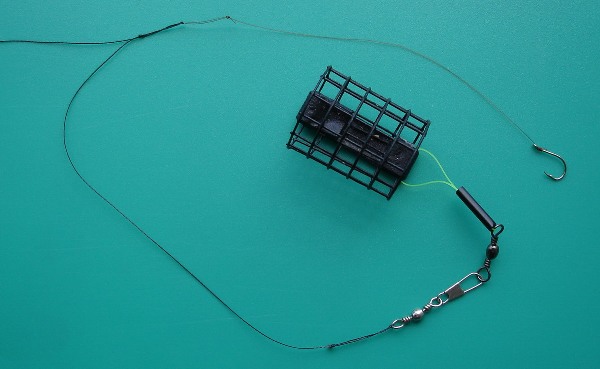
This tackle is quite simple, according to the principle of action, it is similar to the summer analogue. The winter feeder consists of the following parts:
- a 50-70 cm long winter fishing rod with a 0.5 OZ test carbon fiber whip, a cork handle fitted with a reel seat;
- small spinning reel size 500;
- main line section 0.16-0.18 mm;
- equipment such as "Paternoster", "Inline", "Helicopter", "Gardner's loop".
Video: "Helicopter" ("Parachute") winter tackle for catching bream in the current.
Monofilament or high-quality fluorocarbon with a section of 0.12 -0.14 mm is used as a leash material. Hooks are of medium size No. 12-14 with a long, thin forend.
You can fish with such tackle in rivers with currents of different strength. The fishing process involves the use of at least two fishing rods installed in two holes located at a distance of 0.5-1 meters from each other. A feeder in a rig is thrown into the hole located upstream, with a feeder weighing 20-30 grams. A feeder in a rig is thrown into the second hole, and the feeder is replaced with a pear-shaped sinker of equal weight.
The essence of fishing is that the feeder located upstream of the feeder, when the bait is washed out in it, creates a feed path that attracts fish not only to its hooks, but also to the hooks of the nearby tackle.
The bites of the bream on the winter feeder are clearly visible on the bend of the thin whip of the fishing rod. With this method of fishing, the fish is hooked not by the line, but directly by the fishing rod; when playing, the line is exhausted by rotating the reel.
It is very important when fishing to correctly adjust the friction brake - when playing large bream, this will allow you to pull even very large fish to the hole.
Video: winter fishing for bream on an ice feeder
How to feed bream in winter when fishing in the current
Bait for bream in winter on the current, as well as in stagnant water, is of great importance - without using it, you should not count on a decent catch. The bait mixture for catching bream on the river must be strictly balanced. Its main components are:
- The foundation - finely ground, dusty components when the bait is washed out, creating mud that attracts fish or a feed path. The basis for river fishing for bream in winter is used bread crumbs, sunflower oil cake, fish crushed into powder compound feed.
- Stern part - components, when the bait is washed out, do not move a great distance from the rig and create a forage spot on the bottom. The aft part includes cooked cereals - pearl barley, millet, "Hercules", as well as canned corn, peas. In addition to plant components, in order to attract fish, the bait for which it is planned to fish should be present in the aft part of the bait - small fodder bloodworm, maggot, small worm.
- Flavors and additives- honey, garlic, anise, fried and finely ground peanuts, sunflower seeds, unrefined rapeseed or sunflower oil. Flavors are added to the groundbait in very small quantities in winter, since cold water does not transmit odors well over long distances.
In percentage terms, the base is about 70-75% of the mass of the entire mixture, the feed part is 20-25%. Flavors and additives are lightweight and are not included in the percentage of groundbait fractions.
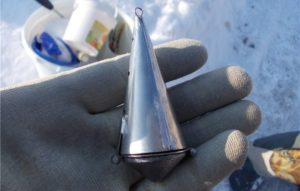
The feeding process when fishing for bream in the current is different from that used in stagnant water. It consists of the following operations:
- Adding fresh bait and water from the hole to a homemade or purchased groundbait mixture.
- Mixing the bait until a homogeneous mass is obtained with a dense consistency.
- Stuffing a heavy rack feeder.
- Descent of the feeder into a separate hole located upstream of the fishing site.
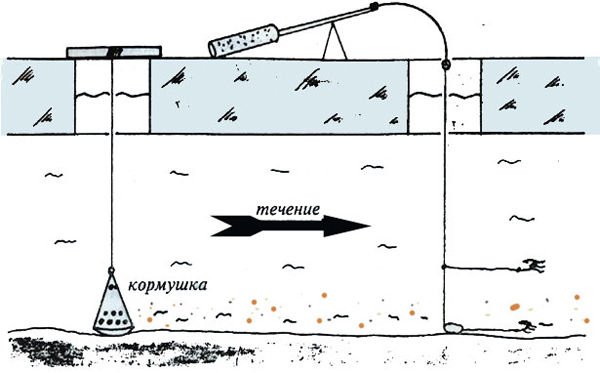
With this method of feeding, the food eroded by the current will gradually be transferred to the working hole with the gear thrown into it - dust-like particles form a long path of turbidity, and heavier food components will roll along the bottom, getting stuck in the unevenness of its soil. With a tangible flow and rapid erosion of the bait in the trough, ballast is added to the mixture - dirt or silt, extracted with the bloodworm.
They do not use feeders for feeding bream on the river - "dump trucks" - the bait unloaded by them to the bottom is very quickly washed out and carried away with the water flow much downstream.
By the way! More details about bait bream in winter read in this article.
Thus, having understood the essence of how to catch bream in the winter on the current, you can fish successfully throughout the winter, delighting yourself with worthy catches.

